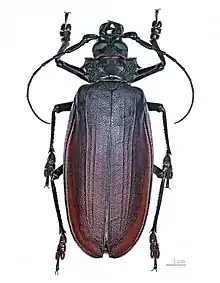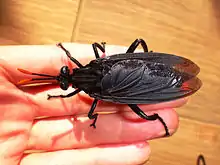List of largest insects
Insects, which are a type of arthropod, are easily the most numerous group of multicellular organisms on the planet, with over a million species identified so far.[1] The title of heaviest insect in the world has many rivals, the most frequently crowned of which is the larval stage of the goliath beetle, Goliathus goliatus, the top size of which is at least 115 g (4.1 oz) and 11.5 cm (4.5 in). The largest confirmed weight of an adult insect is 71 g (2.5 oz) for a giant weta, Deinacrida heteracantha,[2] although it is likely one of the elephant beetles, Megasoma elephas and Megasoma actaeon, or goliath beetles, both of which can commonly exceed 50 g (1.8 oz) and 10 cm (3.9 in), can reach a higher weight.[2]


The longest insects are the stick insects, see below.
Representatives of the extinct dragonfly-like order Meganisoptera (also known as griffinflies) such as the Carboniferous Meganeura monyi and the Permian Meganeuropsis permiana are the largest insect species ever known. These creatures had a wingspan of some 71 cm (28 in). Their maximum body mass is uncertain, with estimates varying between 34 g[3] and 240 g.[4]
Cockroaches (Blattodea)
The largest cockroach in length and wingspan is the South and Central American Megaloblatta, at up 9.7 cm (3.8 in) and 18.5–20 cm (7.3–7.9 in) respectively.[5][6] Another contender for longest is Blaberus giganteus, which is found in the same general region and may reach a length of up to 9 or 10 cm (3.5 or 3.9 in), depending on source.[7][8] The heaviest is the Australian giant burrowing cockroach (Macropanesthia rhinoceros), which can attain a length of 8.4 cm (3.3 in) and a weight of 33.5 g (1.18 oz).[5]
Beetles (Coleoptera)
The beetles are the largest order of organisms on earth, with about 400,000 species so far identified. The most massive species belong to the genera Goliathus, Megasoma, Chalcosoma, Titanus, and Xixuthrus. The longest species is the Hercules beetle, Dynastes hercules, with a maximum overall length of at least 16.7 cm (6.6 in) including the very long pronotal horn.
Earwigs (Dermaptera)
The largest of the earwigs is the Saint Helena earwig (Labidura herculeana), which is up to 8.4 cm (3.3 in) in length. There are no recent records of this species and it is generally considered extinct.[9] The largest certainly living species is the Australian giant earwig (Titanolabis colossea), which is about 5 cm (2.0 in) long.[10]
True flies (Diptera)

The largest species of this huge order is Gauromydas heros, which can reach a length of 6 cm (2 1⁄4 in) and a wingspan of 10 cm (3.9 in).[5] The largest species of crane fly (which are much thinner than Gauromydas) is Holorusia brobdignagius. It can attain about the same head-and-body length and wingspan, but if the legs are extended in front of and behind the body, then an overall length of 23 cm (9.1 in) makes it the longest true fly.[5]
Mayflies (Ephemeroptera)
The largest mayflies are members of the genus Proboscidoplocia from Madagascar. These insects can reach a length of 5 cm (2.0 in).
True bugs (Hemiptera)
The largest species of this diverse, huge order are the giant water bugs Lethocerus grandis and L. maximus.[11] These can surpass a length of 12 cm (4.7 in),[12] although they are more slender and less heavy than most other insects of this size (principally the huge beetles).
Ants, bees, and wasps (Hymenoptera)
The largest of the ants, and the heaviest species of the family, are the females of Dorylus helvolus, reaching a length of 5 cm (2.0 in). The ant that averages the largest for the mean size of the whole colony is Dinoponera gigantea, averaging up to 3.3 cm (1 1⁄4 in). Another ant that is native to Australia, Myrmecia brevinoda, workers are reported to be 3.7 cm (1.5 in) on average and queens are more than 4 cm (1.6 in) in length.[13]
The largest of the bee species, also in the order Hymenoptera, is Megachile pluto, the females of which can be 3.8 cm (1 1⁄2 in) long, with a 6.3-cm (2.5-in) wingspan.
The largest wasp is probably the so-called tarantula hawk species Pepsis pulszkyi, at up to 6.8 cm (2.7 in) long and 11.6 cm (4 1⁄2 in) wingspan, although many other Pepsis species approach a similar size. The giant scoliid wasp Megascolia procer may rival the tarantula hawks in weight, if not length and wingspan, and queens of the Asian giant hornet (Vespa mandarinia) can reach a body length exceeding 5 cm long with a 7.6 cm (3.0 in) wingspan.[14]
Termites (Isoptera)
The largest of the termites is the African species Macrotermes bellicosus. The queen of this species can attain a length of 10.6 cm (4.2 in) and breadth of 5.5 cm (2.2 in); other adults, however, are about a third of this size.
Butterflies and moths (Lepidoptera)

The largest species is probably either the Queen Alexandra's birdwing, Ornithoptera alexandrae, a butterfly, or the Atlas moth, Attacus atlas. Both of these species can exceed a length of 8 cm (3 1⁄4 in), a wingspan of 28 cm (11 in) and a weight of 12 g. Their larvae can weigh up to 58 g (2.0 oz). However, the white witch, Thysania agrippina, has the longest recorded wingspan of the order, and indeed of any living insect, at up to 30 cm (12 in), though it is exceeded in surface area and mass by both Ornithoptera and Attacus. The largest moth in terms of body mass is the giant wood moth Endoxyla cinereus. Despite having a smaller wingspan than the other species, it has a mass of about 30 grams and outweighs them all.
Praying mantises (Mantodea)
Giant shield mantids of the genus Rhombodera can reach lengths of nearly 12 cm (4.7 in) and are more robust than comparably sized mantids of other genera (Tenodera, Macromantis, Hierodula, Idolomantis, Sphodromantis, Deroplatys, Heterochaeta, and Plistospilota). Some larger species have been known to capture and consume frogs, lizards, mice, small birds, and even snakes. Giant Stick Mantids of the genus Toxodera and Solygia can reach lengths of 20 cm, but are more gracile in build than other large mantids.
Dobsonflies and relatives (Megaloptera)
Megaloptera includes dobsonflies, alderflies and relatives. The largest is the dobsonfly Acanthacorydalis fruhstorferi, which can have a wingspan of up to 21.6 cm (8.5 in), making it the largest aquatic insect in the world by this measurement.[15] This species is native to China and Vietnam, and its body can be up to 10.5 cm (4.1 in) long.[16]
Dragonflies and damselflies (Odonata)
The largest living species of odonate (the order that includes dragonflies and damselflies) is Megaloprepus caerulatus, attaining a size of as much as 19 cm (7.5 in) across the wings and a body length of over 12 cm (4.7 in).
Grasshoppers, crickets, and relatives (Orthoptera)
Arachnacris katydids and Tropidacris grasshoppers reach up to 12–15 cm (4.7–5.9 in) in length and 23–27.5 cm (9.1–10.8 in) in wingspan, making them the largest by these measurements.[5][10] The largest Saga and Pseudophyllus bush crickets are only are a few centimeters smaller.[10]
The heaviest of this widespread, varied complex of insects is the Little Barrier Island giant weta, Deinacrida heteracantha, of New Zealand; one specimen weighed 71 g (2.5 oz) and measured nearly 10 cm (3.9 in).[2]
Stick insects (Phasmatodea)
_on_Sylvain_(8727651923).jpg.webp)
The longest known stick insects are also the longest known insects, but they are generally relatively lightweight because of their slender shape. The longest is an unnamed species of Phryganistria discovered in China in 2016, where a specimen held at the Insect Museum of West China in Chengdu has a total length of 62.4 cm (24.6 in).[17] The second-longest species is the Australian Ctenomorpha gargantua, females of which have been measured at over 60 cm (24 in) in total length.[18] Other very large species, formerly believed to be longest but now considered third and fourth longest, are Phobaeticus chani and P. serratipes. A specimen of the former held in the Natural History Museum in London has a total length of 56.7 cm (22.3 in) and a specimen of the latter is 55.5 cm (21.9 in).[19][20] These measurements are, however, with the front legs fully extended. In P. chani, the body alone still measures 35.7 cm (14.1 in).[21] Another very large species is P. kirbyi where the total length (including extended legs) is up to 54.6 cm (21.5 in) and the body alone up to 32.8 cm (12.9 in).[22]
Stoneflies (Plecoptera)
The largest species of stonefly is Pteronarcys californica, a species favored by fishermen as bait. This species can attain a length of 5 cm (2.0 in) and a wingspan of nearly 7.5 cm (3.0 in).
Booklice (Psocoptera)
The largest of this order of very small insects is the barklouse of the genus Psocus, the top size of which is about 1 cm (0.39 in).
Fleas (Siphonaptera)
The largest species of flea is Hystrichopsylla schefferi. This parasite, known exclusively from the fur of the mountain beaver, can reach a length of 1.2 cm (0.47 in).
Thrips (Thysanoptera)
Members of the genus Phasmothrips are the largest thrips. The maximum size of these species is about 1.3 cm (0.51 in).
References
- Zhang Z-Q, ed. (2011) Animal Biodiversity: An Outline of Higher-Level Classification and Survey of Taxonomic Richness. Auckland, N. Z.: Magnolia Press
- Williams, David M (2001-04-21). "Chapter 30 — Largest Insect". Book of Insect Records. University of Florida. Archived from the original on 2014-08-20.
- Dorrington, Graham E. (2016-04-01). "Heavily loaded flight and limits to the maximum size of dragonflies (Anisoptera) and griffenflies (Meganisoptera)". Lethaia. 49 (2): 261–274. doi:10.1111/let.12144. ISSN 1502-3931.
- Polet, Delyle (2011-05-06). "The Biggest Bugs: An investigation into the factors controlling the maximum size of insects". Eureka. 2 (1): 43–46. doi:10.29173/eureka10299. ISSN 1923-1520.
- Carwardine, M. (2008). Animal Records. Natural History Museum, London. pp. 229–230. ISBN 978-1-4027-5623-8.
- "Largest cockroach". Guinness World Records. Retrieved 30 March 2018.
- "Allpet Roaches;Blattodea Rearing". Allpet. Retrieved 2019-07-15.
- Davis, Shkora (2015). "Blaberus giganteus (Giant Cave Cockroach)" (PDF). The Online Guide to the Animals of Trinidad and Tobago.
- "Labidura". Archived from the original on 2011-02-05. Retrieved 2011-02-05.
- Flindt, R. (2006). Amazing Numbers in Biology. Springer. p. 10. ISBN 978-3-540-30146-2.
- P.J., Perez-Goodwyn (2006). "Taxonomic revision of the subfamily Lethocerinae Lauck & Menke (Heteroptera: Belostomatidae)". Stuttgarter Beiträge zur Naturkunde, Serie A (Biologie). 695: 1–71.
- Haddad, V.; Schwartz; Schwartz; Carvalho (2010). "Bites Caused by Giant Water Bugs Belonging to Belostomatidae Family (Hemiptera, Heteroptera) in Humans: A Report of Seven Cases". Wilderness & Environmental Medicine. 21 (2): 130–133. doi:10.1016/j.wem.2010.01.002. PMID 20591375.
- Wood, Gerald The Guinness Book of Animal Facts and Feats (1983) ISBN 978-0-85112-235-9
- Vespa mandarinia factsheet
- "Largest aquatic insect (by wingspan)". Guinness World Records. Retrieved 4 April 2018.
- Xing Yue Liu; Ding Yang; Si Qin Ge; Xing Ke Yang (2005). "Phylogenetic review of the Chinese species of Acanthacorydalis (Megaloptera, Corydalidae)". Zoologica Scripta. 34 (4): 373–387. doi:10.1111/j.1463-6409.2005.00197.x. S2CID 84988447.
- "Longest Insect discovered in China".
- Brock, Paul D.; Hasenpusch, Jack W. (2009). The Complete Field Guide to Stick and Leaf Insects of Australia. CSIRO Publishing. p. 106. ISBN 9780643094185.
- "World's longest insect revealed". Natural History Museum. 2008-10-16. Archived from the original on 2008-10-19. Retrieved 2008-10-16.
- Seow-Choen, F. (1995). The longest insect in the world. Malayan Nat. 48: 12.
- Hennemann, F.H. & Conle, O.V. (October 2008). "Revision of Oriental Phasmatodea: The tribe Pharnaciini Günther, 1953, including the description of the world's longest insect, and a survey of the family Phasmatidae Gray, 1835 with keys to the subfamilies and tribes (Phasmatodea: "Anareolatae": Phasmatidae)" (PDF). Zootaxa. Auckland, New Zealand: Magnolia Press. 1906: 1–316. doi:10.11646/zootaxa.1906.1.1. ISSN 1175-5326. Retrieved 2008-10-16.
- Brock, P.D. 1999. The amazing world of stick and leaf-insects. Cravitz Printing Co., Essex, England.